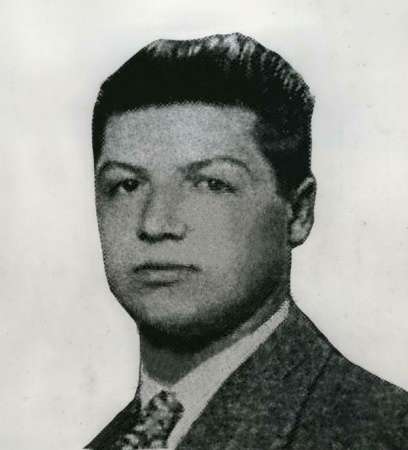The year was 1945 and 32-year-old Lona Cohen from Adams, Mass., was in the New Mexico desert. Americans had perfected the nuclear bomb and used it to end World War II. In the Los Alamos desert the security around the nuclear labs was intense. The Soviet Union desperately wanted to build their own nuclear weapons, and Communists had persuaded a young physicist, Theodore Hall, to smuggle secrets from the lab and deliver them to the Soviets.
Hall handed off a trove of documents to a crafty courier, Lona Cohen, and she immediately boarded a train to New York. From there her contacts could get the documents to Russia. Lona was stunned to see military police board the train and begin searching passenger belongings. Cool and polished as ever, Lona folded the secret documents into her newspaper.

When police arrived at her seat, she asked the soldier if he would mind holding her newspaper while she opened her bags for him. He happily complied and returned the newspaper when he had verified that Cohen didn’t smuggle any nuclear secrets in her bags.
The Legend of Lona Cohen
Lona Cohen became a legend in the Soviet KGB that day. And the Soviets would develop their first nuclear bomb based on the plans she carried out of Los Alamos that day.
So how did a small-town girl from Adams, Mass., get to become a Soviet spy funneling state secrets from West to East for more than 25 years? Historians don’t know the details.
Lona was born Leontine Petka in 1913 in Adams into a large Polish Catholic family. Her father worked in a cotton mill. The family moved to Taftville, Conn., in 1923, and at 15 Lona left home to move to New York City.
Lona had a front row seat to watch the collapse of the economy and the misery brought on by the Great Depression. Disenchanted with America’s ruling elite, she joined the Communist Party and married Morris Cohen, who fashioned himself a Communist intellectual.

Morris Cohen
As early as 1938 Morris affiliated with Russian intelligence, eavesdropping and couriering information to Russia. In 1940, Morris was drafted to serve in World War II. Lona took on more responsibility, which led to her dramatic trip to Los Alamos.
Cold War
As the Cold War heated up, so did the search for Russian spies. The Morrises knew Ethel and Julius Rosenberg, and their arrest in 1951 shook them. Panicked by news that the FBI was on to them, but clever as always, Morris and Lona escaped detection. The Soviets brought them to Mexico and then Russia.
In Russia, the Soviets developed new identities for Lona and Morris. They became Peter and Helen Kroger – antiquarian bookdealers from New Zealand who had resettled in London. In London, they became central players in a spy ring operating in England for seven years. They had a secret radio tower built in their house, which they used to relay messages to Russia.

The “Kroger” house in London
While in England, the Morris’ belonged to the Portland Spy Ring, sending British naval secrets to Russia. The leader of the ring drew suspicion on himself with lavish spending and drunkenness. The Morris/Krogers, meanwhile, were not exactly discreet.
In her book The Duchess of Bloomsbury Street, author Helene Hanff told the story of how the couple was nearly outed at a New Year’s Eve party by their host. She remarked on Lona/Helen’s exquisite black dress: “‘Helen, you look like a Russian spy!’ she said. And Helen laughed and Peter laughed and a few months later we picked up the morning paper and discovered that Helen and Peter Kruger were Russian spies.”
Lona tried one last clever move as police raided her home. Could she, she asked, stoke the boiler to keep the house warm before leaving with police? This time her captors were a step ahead of her. They followed her to the basement and stopped her from tossing secret stolen documents into the furnace.
Freedom
In 1961, Lona and Morris were convicted and sent to prison. After eight years, the British exchanged them for a British citizen imprisoned in Russia. The KGB gave them a hero’s welcome.
Lona died in 1992 and Morris in 1995. He received a hero’s funeral. Despite their arrest, the two had kept their secrets.The identity of Theodore Hall, the physicist who handed those atomic secrets to Lona in the desert all those years ago, was not revealed until after Lona and Morris had died – long after the collapse of the Soviet Union. The Soviets decorated Lona with the Honor of The Red Banner and the Order of Friendship Peoples. The Russian government issued a commemorative postage stamp bearing her likeness.
This story was updated in 2022.
Images: Cohens’ home in London By Russell Trebor, CC BY-SA 2.0, https://commons.wikimedia.org/w/index.php?curid=12409365.



11 comments
You never know who your neighbora are.
You never know who your neighbora are.
You never know who your neighbora are.
Why are honoring a traitor to our country?
I think it’s just an interesting story from history. I don’t think they’re honoring her at all, just telling the story. She was indeed cool and quick-thinking, even if she was on the side we don’t support!
Why is the couple twice referred to as “the Morris'” when, in fact, they are the Cohen’s?
Since her huband’s name was Morris Cohen, the couple’s “collective” name should have been the Cohens, not the Morrises, right? Unless they changed their name from Cohen to Morris, before becoming the Krogers. Editing is crucial in communicating, particularly a convoluted mistaken-identity story, such as this one, wouldn’t you agree?
Ethel Rosenburg’s father (can’t remember his name) was known as the Adirondack Santa Claus in my area of the Adirondack Mts as I remember. I believe he owned a toy store in NYC area. In December a fairly large shipment of toys including dolls for girls and trucks for boys arrived probably by rail freight to be distributed to children in needy families. My Aunt who taught 1st and 2nd grades was one of those chosen to distribute them as she would know who should get them. I am fairly sure this recollection of mine is correct as I seem to remember how the local adults felt sorry for this man to have his daughter turn out to be a spy. I can remember seeing the toys stacked up in my Aunt’s living room. I don not know what this man’s connection was with our area but many NYC people had vacation homes in ours area and knew the people around them well. This took place in the 1930’s.
The author wrote this in a manner that glorifies these American and, later, British traitors. For a political scheme — communism — that was already documented during their criminal careers as being a bogus system that cheated the proletariat through massive corruption and inefficiencies by the state. What next? That Edward Snowden, a similar thief of classified sectets of this era who also fled to Russia, also gets an odd heroes write-up in this publication? Maybe Americans will only wake up to the reality of these traitors, and skip the praise for their perfidy, when we lose a major war amd are enslaved by our foes.
[…] Viennese author Felix Salten. The book was translated into English by Whittaker Chambers, a former Soviet spy. (Chambers famously testified against Alger Hiss in his perjury trial, which was compared with the […]
[…] The grateful Russian nation awarded Rees a medal for his activities and granted him a pension, in addition to some $30,000 for his help. The United States, however, no longer having an alliance with the USSR after the conclusion of World War II, viewed Rees as an enemy spy. […]
Comments are closed.